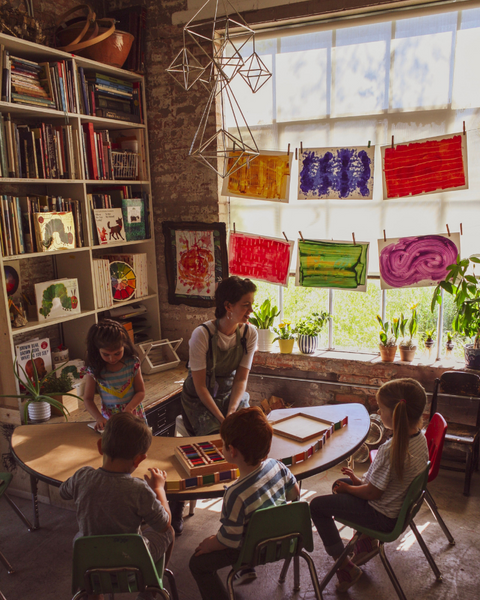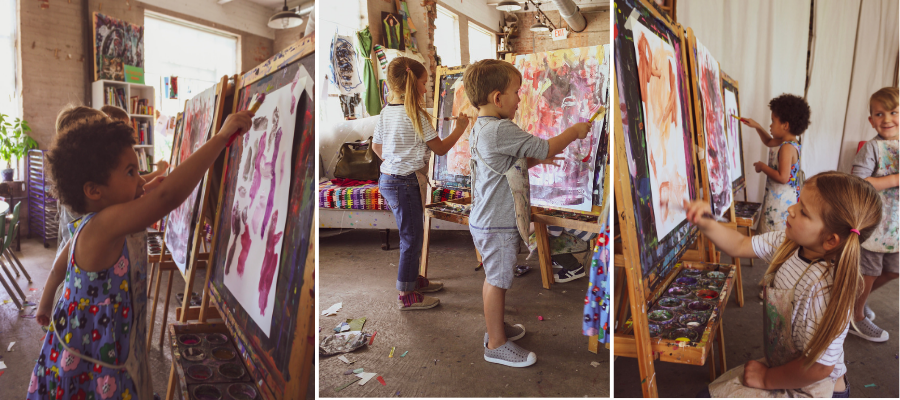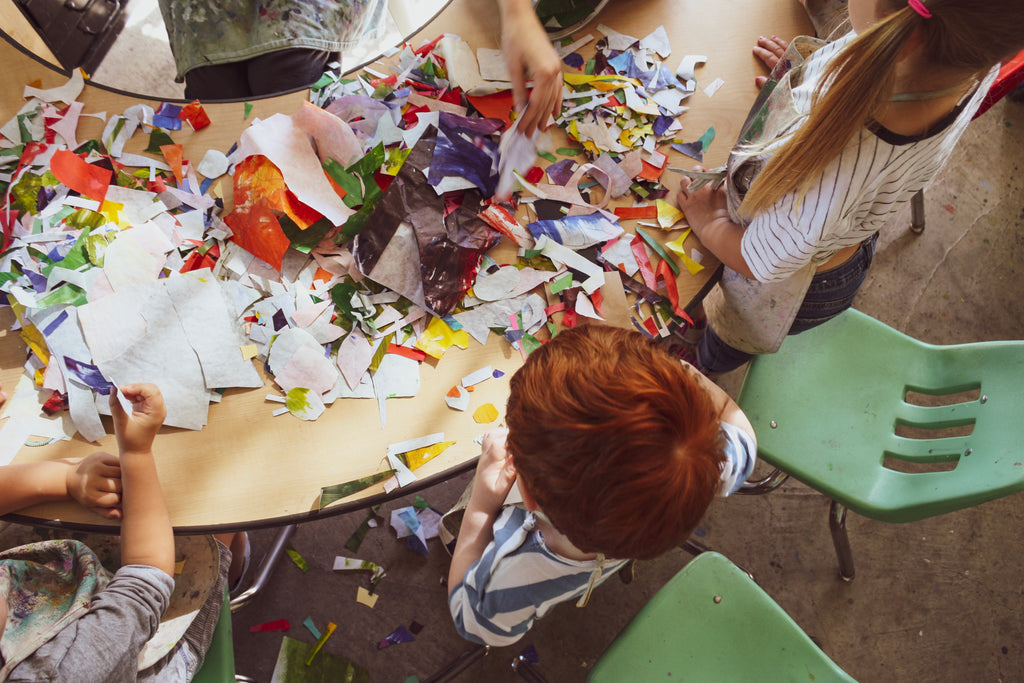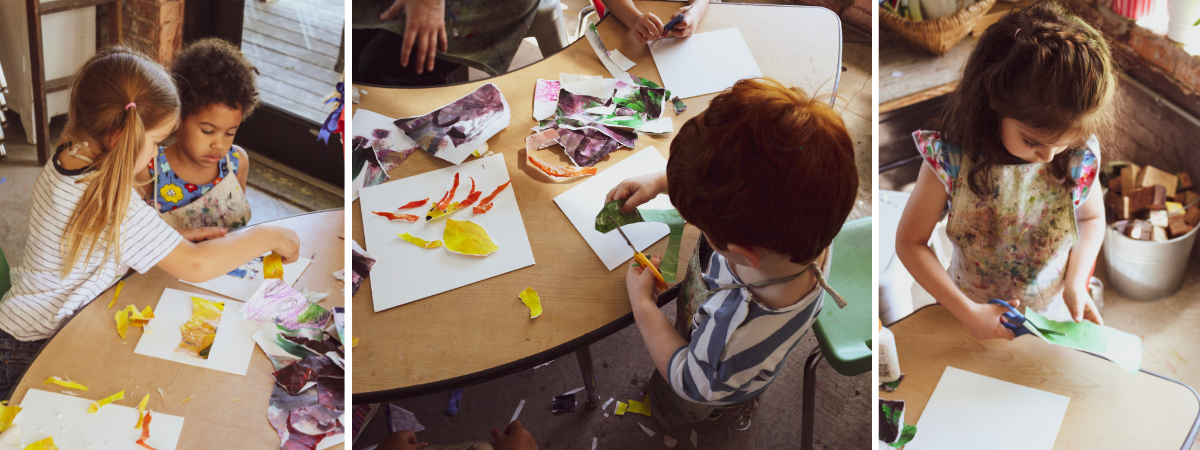One of the things often overlooked about Eric Carle's enduring art are the simple techniques that he uses to create it. In a world where images are developed and manipulated with the aid of tech, Carle's process is refreshingly handmade. Learning how he builds his images and trying it first hand is a multi-sensory experience that can deepen and enhance children's enjoyment of their favorite Eric Carle books, as well as inviting them to express their own ideas in a new way.
We partnered with our favorite art studio, Oil and Cotton, to demonstrate Carle's techniques and model fun ways to explore them with your little ones at home. Oil and Cotton co-founder Kayli House led a small workshop with children ages 3-6 as they took a closer look at Carle's classic The Very Hungry Caterpillar and then made their own original collages using his techniques.
The definitive resource for Carle's process is The Official Eric Carle Website. On the resource page you will find a series of Resources for Creative Projects, including a printable collage making instruction sheet and several slide shows of Carle himself demonstrating his techniques. Our workshop at Oil and Cotton is based on these instructions and demonstrations, but Kayli taught us some useful adaptations for younger artists as well as several clever add-ins to build gross and fine motor skills and art vocabulary.
Let's get started!
As our young artists arrive, Kayli invites them to put on aprons and join her at the table.
The kids begin by taking a closer look at The Very Hungry Caterpillar and talking about the shapes and colors they see.
"I see yellow cheese!"
"The pickle is green."
"It's all the colors in the rainbow."
Kayli explains that Eric Carle makes his colors by applying layers of paint to tissue paper with a paint brush. He needs to make a lot of these to build a collage!
For a group of children this young, Kayli is using regular white butcher paper instead of actual tissue paper, which can easily tear while the paint is being applied. She prepares paint trays with non-toxic acrylic paint and sets each artist up with their own brush and easel, then invites them to fill their pages with color.

A blank page can be intimidating at first...
But soon, everyone is engaged.
It's great to encourage children to draw and paint while standing whenever possible. This allows them to use their whole body in the process, and move from the shoulder rather than the wrist or elbow. There is a link for an affordable children's folding easel like those pictured here in the resources section at the end.
While the paintings dry (a hairdryer will work like magic if you are trying this at home!), everyone moves back to the table to talk about texture. Eric Carle adds texture to his tissues in a variety of ways, from scratching or inscribing into the paint itself to dabbing paint on with a sponge or dry paint brush.
Texture can be added to wet paint by inscribing lines with the blunt end of a paint brush.
Kayli introduces the idea of texture with a box of texture tiles (pieces of cardboard with a variety of thin materials glued to them) for everyone to feel. Everyone takes turns describing the textures.

"This one is bumpy!"
"Sandpaper feels scratchy."
"The wood is smooth."
Eric Carle uses visual texture in his collages - texture that you "feel" with your eyes.
The paintings are now dry, so everyone begins to add layers of texture to their painting with crayons. Variations include making lines, rubbing the paper with the side of the crayon, or placing a texture tile under the paper and rubbing with the side of the crayon on top of the paper so the texture emerges.

The artists here are using a sustainable wax drawing tool Kayli recommends called Crayon Rocks. Their rounded shape is easy for little fingers to grasp in a tripod grip, and they are available in a variety of brilliant colors (linked in the resources section at the end). Block crayons or ordinary crayons with the paper removed work too!
As they work, the kids try to guess how Eric Carle made the different textures on the butterfly in The Very Hungry Caterpillar. There are so many textures there! Kayli asks them to also notice the edges of the shapes in his pictures. Are they smooth or rough? Do you think he made them with scissors, or by tearing the paper?
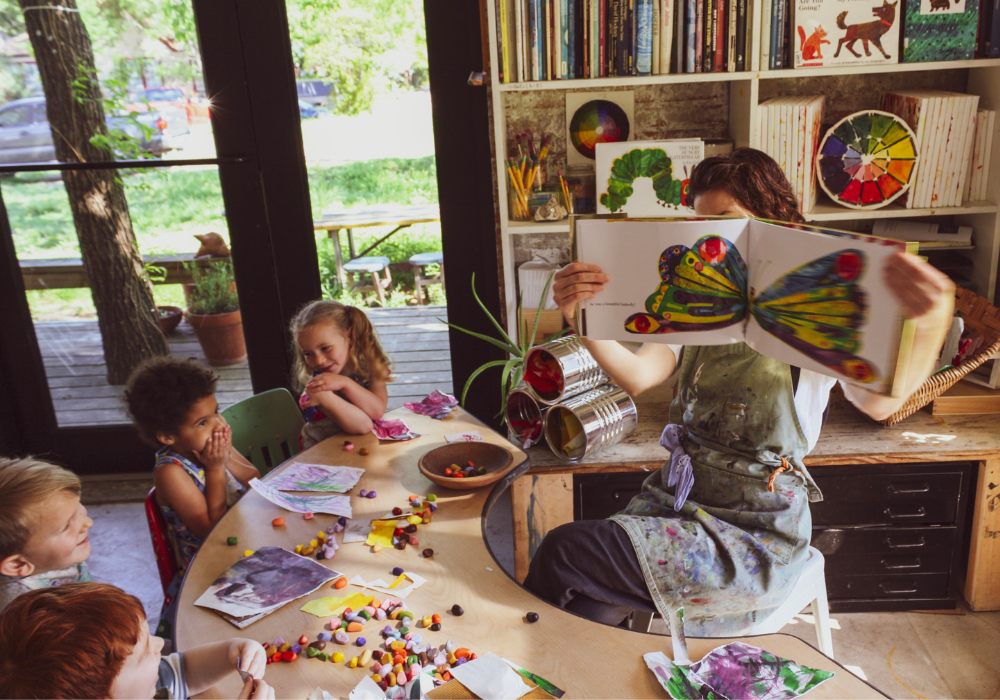
Now it's time to put the crayons away and begin to collage!
One of the core philosophies of Oil and Cotton is recycling and using what you have on hand. Along these lines, Kayli has a large basket of collected paper collage scraps left over from classes and camps. Because she is working with six children in our demonstration, she pulls the scraps out so everyone can select pieces to add to the painted papers they just created. You can replicate this at home by saving your collage scraps for your next project, or spreading the project over two days, making a batch of painted tissues one day and assembling the collage the next.
Eric Carle organizes his tissues in wooden drawers, sorted by color and value. Sorting and storing your painted papers for another day is a great add-on activity!
The fresh variety of colors and shapes get everyone's ideas flowing.
"This looks like grass!"
"This yellow could be a giraffe or a cat."
"What could this pink color be?"
White pieces of cardstock are passed out to use as backgrounds and the artists begin to compose their collages. The kids think out loud as they consider different ideas and what colors they want to use. Kayli encourages them to cut and tear the paper into the shapes they need. At this young age, both cutting and tearing will develop motor skills and build the muscles in the hand that are crucial for holding a pencil and gripping objects.
Animals emerge as a popular collage subject, so the group talks about building each different part - an oval or rectangle for the body, narrow strips for legs and neck, a small oval for a head, small triangles for ears. Shapes are moved around the white backgrounds and simple compositions develop.
When the pieces are arranged, paper glue is used to hold them in place. If you have access to a rubber brayer (roller) they are perfect for pressing down all the layers - and super fun to use! If there is a lot of excess glue on the artwork, place a piece of wax paper on top before rolling to avoid getting glue on the roller.
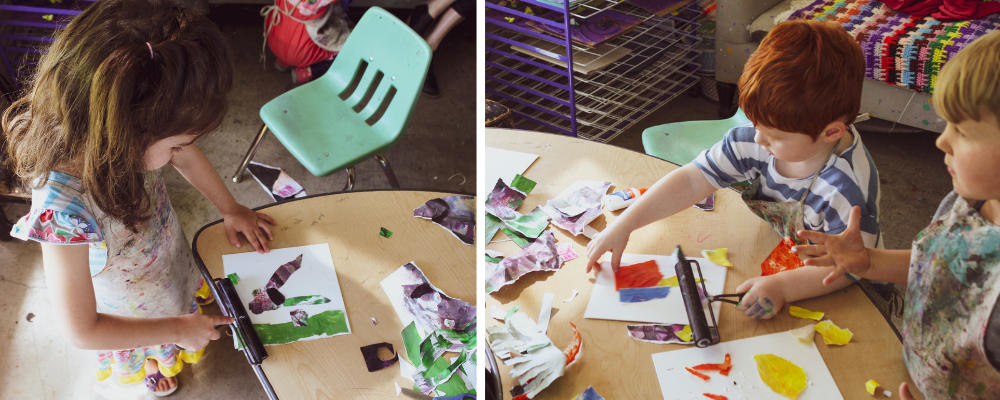
When every last piece has been glued into place, it's time to appreciate the finished collages. Don't forget to sign and date your artwork!
Remember that our goal here is experience and exploration, so if your little artist runs out of steam before their collage is complete that is just fine. Take time to talk about whatever end result in a specific way ("I love how you did...." rather than "It's beautiful! I love it!"). Revisit this at a later time, children love to hear you verbalize their actions and it reinforces the experience.
"Look how long that giraffe's neck is! You made it go right off the page!"
"I love how you placed big shapes next to the small ones, and red next to blue."
"You overlapped the bunny on the strip of green grass so it looks like it is on top of the grass."
Kayli wraps things up at Oil and Cotton with one last Eric Carle story on the couch.

We would like to say a very special thank you to Kayli House and Oil and Cotton Creative Exchange. Visit their website for the very best classes, camps, workshops and events for all ages taught by professional artists and makers, as well as thoughtfully curated art supplies and materials in their Store (we highly recommend their birthday parties and adult retreats!). Stop by and visit them in person at 817 W. Davis St. #110, Dallas, TX.
We are so grateful for our amazing young artist participants Quinn, Rosalie, Catherine Lucia, Zoe, Tucker, and Felix, as well as their parents. They were up for anything and so much fun to make art with!
Resources

Crayon Rocks are developmentally designed for young children and made in the USA.
Our favorite folding MÅLA Easel is from Ikea and a deal at only $19.99.
If space is limited, Blick Art Supplies has a tabletop easel children can use while standing for $16.49.
We also like Blick's Student Acrylic Mixing Set. It's an economical acrylic paint set that is non-toxic and comes out of clothing with baby wipes (if treated while paint is still wet).
The Official Eric Carle Web Site is full of resources for parents, teachers, and educators.
The Art of Eric Carle from Penguin Random House is a brilliant retrospective of Carle's work for those who are interested in learning more about his collage techniques.
Collages are a great Birthday Party activity! We've curated all sorts of fun Eric Carle party ideas on our Very Hungry Caterpillar Pinterest Board.
The Eric Carle Museum of Picture Book Art in Amherst, Massachusetts has exhibitions, programs, and events year round to inspire and delight the whole family.
Reading Picture Books with Children by Megan Dowd Lambert was developed in conjunction with the Eric Carle Museum of Picture Book Art and offers a practical guide for reshaping storytime and getting kids to "think with their eyes".
And of course, shop the entire
World of Eric Carle™ + Little Goodall Collection online!


